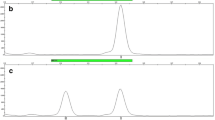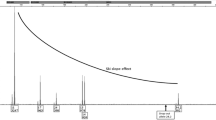Abstract
DNA becomes progressively more fragmented as biological tissue degrades resulting in decreasing ability to gain a complete DNA profile. Successful identification of samples exhibiting very high levels of DNA degradation may be complicated by presenting in minute quantities. The industry standard method for human DNA identification utilising short tandem repeats (STR) may produce partial or no DNA profile with such samples. We report a comparative study of genotyping using STRs, mini-STRs and single nucleotide polymorphisms (SNPs) with template at different levels of degradation in varying amounts. Two methods of assessing quantity and quality of a DNA sample prior to genotyping were investigated. The QIAxcel capillary gel electrophoresis system provided a rapid, cost effective screening method for assessing sample quality. A real-time quantitative PCR (qPCR) assay was able to simultaneously quantify total human DNA, male DNA, DNA degradation and PCR inhibition. The extent of DNA degradation could be assessed with reasonable accuracy to 62.5 pg and genomic targets could be quantified to a lower limit of 15.6 pg. The qPCR assay was able to detect male DNA to a lower limit of 20 pg in a 1:1,000 background of female DNA. By considering the amount of DNA and the degradation ratio of a sample, a general prediction of genotyping success using AmpFlSTR® Profiler Plus®, MiniFiler™ kits and SNP analysis can be made. The results indicate mini-STRs and SNP markers are usually more successful in typing degraded samples and in cases of extreme DNA degradation (≤200 bp) and template amounts below 250 pg, mini-STR and SNP analysis yielded significantly more complete profiles and lower match probabilities than corresponding STR profiles.




Similar content being viewed by others
References
Brenner CH, Weir BS (2003) Issues and strategies in the DNA identification of World Trade Center victims. Theor Popul Biol 63(3):173–178
Fondevila M, Phillips C, Naverán N, Cerezo M, Rodríguez A, Calvo R, Fernández LM, Carracedo Á, Lareu MV (2008) Challenging DNA: assessment of a range of genotyping approaches for highly degraded forensic samples. Forensic Sci Int Genetics Supplement Series 1(1):26–28
Holland MM, Huffine EF (2001) Molecular analysis of the human mitochondrial DNA control region for forensic identity testing. Curr Protoc Hum Genet Chapter 14:Unit 14 7.
Hellmann A, Rohleder U, Schmitter H, Wittig M (2001) STR typing of human telogen hairs–a new approach. Int J Leg Med 114(4–5):269–273
Alonso A, Martin P, Albarran C, Garcia P, Fernandez de Simon L, Jesus Iturralde M, Fernandez-Rodriguez A, Atienza I, Capilla J, Garcia-Hirschfeld J, Martinez P, Vallejo G, Garcia O, Garcia E, Real P, Alvarez D, Leon A, Sancho M (2005) Challenges of DNA profiling in mass disaster investigations. Croat Med J 46(4):540–548
Grubwieser P, Muhlmann R, Berger B, Niederstatter H, Pavlic M, Parson W (2006) A new “miniSTR-multiplex” displaying reduced amplicon lengths for the analysis of degraded DNA. Int J Leg Med 120(2):115–120
Hill CR, Kline MC, Coble MD, Butler JM (2008) Characterization of 26 miniSTR loci for improved analysis of degraded DNA samples. J Forensic Sci 53(1):73–80
Parsons TJ, Huel R, Davoren J, Katzmarzyk C, Milos A, Selmanovic A, Smajlovic L, Coble MD, Rizvic A (2007) Application of novel “mini-amplicon” STR multiplexes to high volume casework on degraded skeletal remains. Forensic Sci Int Genet 1(2):175–179
Dixon LA, Dobbins AE, Pulker HK, Butler JM, Vallone PM, Coble MD, Parson W, Berger B, Grubwieser P, Mogensen HS, Morling N, Nielsen K, Sanchez JJ, Petkovski E, Carracedo A, Sanchez-Diz P, Ramos-Luis E, Brion M, Irwin JA, Just RS, Loreille O, Parsons TJ, Syndercombe-Court D, Schmitter H, Stradmann-Bellinghausen B, Bender K, Gill P (2006) Analysis of artificially degraded DNA using STRs and SNPs–results of a collaborative European (EDNAP) exercise. Forensic Sci Int 164(1):33–44
Budowle B (2004) SNP typing strategies. Forensic Sci Int 146(Suppl):S139–S142
Kidd KK, Pakstis AJ, Speed WC, Grigorenko EL, Kajuna SL, Karoma NJ, Kungulilo S, Kim JJ, Lu RB, Odunsi A, Okonofua F, Parnas J, Schulz LO, Zhukova OV, Kidd JR (2006) Developing a SNP panel for forensic identification of individuals. Forensic Sci Int 164(1):20–32
Budowle B, van Daal A (2008) Forensically relevant SNP classes. Biotechniques 44(5):603–610
PA FR, Hyland F, Wang D, Shewal J, Kidd JR, Kidd KK, Furtado MR (2009) Multiplexed SNP detection panels for human identification. Forensic Sci Int Genet 2:538–539
Ge J, Budowle B, Planz JV, Chakraborty R (2009) Haplotype block: a new type of forensic DNA markers. Int J Legal Med. doi:10.1007/s00414-009-0400-5
Westen AA, Matai AS, Laros JF, Meiland HC, Jasper M, de Leeuw WJ, de Knijff P, Sijen T (2009) Tri-allelic SNP markers enable analysis of mixed and degraded DNA samples. Forensic Sci Int Genet 3(4):233–241
Pitterl F, Schmidt K, Huber G, Zimmermann B, Delport R, Amory S, Ludes B, Oberacher H, Parson W (2010) Increasing the discrimination power of forensic STR testing by employing high-performance mass spectrometry, as illustrated in indigenous South African and Central Asian populations. Int J Legal Med. doi:10.1007/s00414-009-0408-x
Hudlow WR, Chong MD, Swango KL, Timken MD, Buoncristiani MR (2008) A quadruplex real-time qPCR assay for the simultaneous assessment of total human DNA, human male DNA, DNA degradation and the presence of PCR inhibitors in forensic samples: A diagnostic tool for STR typing. Forensic Sci Int Genet 2(2):108–125
Swango KL, Timken MD, Chong MD, Buoncristiani MR (2006) A quantitative PCR assay for the assessment of DNA degradation in forensic samples. Forensic Sci Int 158(1):14–26
Budowle B, Eisenberg AJ, van Daal A (2009) Validity of low copy number typing and applications to forensic science. Croat Med J 50(3):207–217
Luce C, Montpetit S, Gangitano D, O'Donnell P (2009) Validation of the AMPFlSTR MiniFiler PCR amplification kit for use in forensic casework. J Forensic Sci 54(5):1046–1054
Mulero JJ, Chang CW, Calandro LM, Green RL, Li Y, Johnson CL, Hennessy LK (2006) Development and validation of the ampFlSTR Yfiler PCR amplification kit: a male specific, single amplification 17 Y-STR multiplex system. J Forensic Sci 51(1):64–75
Sanchez JJ, Phillips C, Borsting C, Balogh K, Bogus M, Fondevila M, Harrison CD, Musgrave-Brown E, Salas A, Syndercombe-Court D, Schneider PM, Carracedo A, Morling N (2006) A multiplex assay with 52 single nucleotide polymorphisms for human identification. Electrophoresis 27(9):1713–1724
Applied Biosystems (2006) AmpFlSTR® Identifiler® PCR Amplification Kit. Product Bulletin.
Acknowledgements
We would like to thank the Australian and New Zealand Forensic Science Society (ANZFSS) for funding travel to the 6th International Society of Applied Biological Sciences (ISABS) Conference, 2009 where a portion of this data was presented as a poster.
Any Australian ethical permission necessary for this project has been granted and ethical standards have been adhered to.
Conflict of interest
The authors declare that they have no conflict of interest.
Author information
Authors and Affiliations
Corresponding author
Electronic supplementary materials
Below is the link to the electronic supplementary material.
Online Resource 1
Amplicon length, fluorescence labels, primer and probe concentrations of each target sequence included in the quadruplex qPCR assay. (PDF 22 kb)
Online Resource 2
The RS number and amplicon length of the 53 SNPs genotyped (PDF 22 kb)
Online Resource 3
Sensitivity data of the quadruplex qPRC assay and degradation ratios with undegraded and degraded samples. (PDF 22 kb)
Online Resource 4
Quantification results of male and female mixed samples indicating male: female ratios generated by the quadruplex assay. (PDF 21 kb)
Rights and permissions
About this article
Cite this article
R. Hughes-Stamm, S., J. Ashton, K. & van Daal, A. Assessment of DNA degradation and the genotyping success of highly degraded samples. Int J Legal Med 125, 341–348 (2011). https://doi.org/10.1007/s00414-010-0455-3
Received:
Accepted:
Published:
Issue Date:
DOI: https://doi.org/10.1007/s00414-010-0455-3




